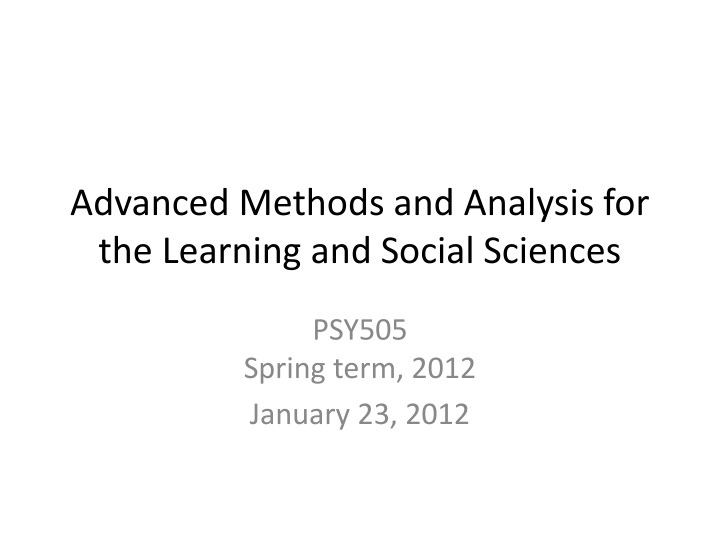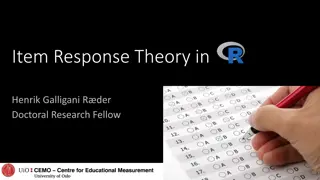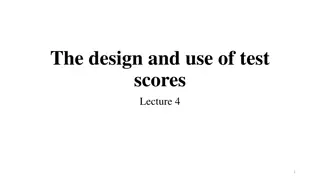
Advanced Methods and Analysis for Learning and Social Sciences - IRT Overview
Dive into the key goals, typical uses, scoring, assumptions, and implications of Item Response Theory (IRT) in educational assessment and measurement. Explore the fundamental concepts behind IRT and its application in evaluating latent traits and student knowledge.
Download Presentation

Please find below an Image/Link to download the presentation.
The content on the website is provided AS IS for your information and personal use only. It may not be sold, licensed, or shared on other websites without obtaining consent from the author. If you encounter any issues during the download, it is possible that the publisher has removed the file from their server.
You are allowed to download the files provided on this website for personal or commercial use, subject to the condition that they are used lawfully. All files are the property of their respective owners.
The content on the website is provided AS IS for your information and personal use only. It may not be sold, licensed, or shared on other websites without obtaining consent from the author.
E N D
Presentation Transcript
Advanced Methods and Analysis for the Learning and Social Sciences PSY505 Spring term, 2012 January 23, 2012
Todays Class Item Response Theory
What is the key goal of IRT? Measuring how much of some latent trait a person has How intelligent is Bob? How much does Bob know about snorkeling? SnorkelTutor
What is the typical use of IRT? Assess a student s knowledge of topic X Based on a sequence of items that are dichotomously scored E.g. the student can get a score of 0 or 1 on each item
Scoring Not a simple average of the 0s and 1s That s an approach that is used for simple tests, but it s not IRT Instead, a function is computed based on the difficulty and discriminability of the individual items
Key assumptions There is only one latent trait or skill being measured per set of items There are other models that allow for multiple skills per item, we ll talk about them later in the semester Each learner has ability Each item has difficulty b and discriminability a From these parameters, we can compute the probability P( ) that the learner will get the item correct
Note The assumption that all items tap the same latent construct, but have different difficulties, is a very different assumption than is seen in other approaches such as BKT (which we ll talk about later) Why might this be a good assumption? Why might this be a bad assumption?
Item Characteristic Curve Can anyone walk the class through what this graph means?
Item Characteristic Curve If Iphigenia is an Idiot, but Joelma is a Jenius, where would they fall on this curve?
Which parameter do these three graphs differ in terms of?
Which of these three graphs represents a difficult item? Which represents an easy item?
For a genius, what is the probability of success on the hard item? For an idiot, what is the probability of success on the easy item? What are the implications of this?
Which parameter do these three graphs differ in terms of?
Which of these three items has low discriminability? Which has high discriminability? Which of these items would be useful on a test?
What would a graph with extremely low discriminability look like? Can anyone draw it on the board? Would this be useful on a test?
What would a graph with extremely high discriminability look like? Can anyone draw it on the board? Would this be useful on a test?
Mathematical formulation The logistic function
The Rasch (1PL) model Simplest IRT model, very popular There is an entire special interest group of AERA devoted solely to the Rasch model (RaschSIG)
The Rasch (1PL) model No discriminability parameter Parameters for student ability and item difficulty
The Rasch (1PL) model Each learner has ability Each item has difficulty b
The Rasch (1PL) model Let s enter this into Excel, and create the item characteristic curve
The Rasch (1PL) model Let s try the following values: = 0 b = 0? = 3 b = 0? = -3 b = 0? = 0 b = 3? = 0 b = -3? = 3 b = 3? = -3 b = -3? What do each of these param sets mean? What is P( )?
The 2PL model Another simple IRT model, very popular Discriminability parameter a added
Rasch 2PL
The 2PL model Another simple IRT model, very popular Discriminability parameter a added Let s enter it into Excel, and create the item characteristic curve
The 2PL model What do these param sets mean? What is P( )? = 0 b = 0, a = 0 = 0 b = 3, a = 0 = 3 b = 0, a = 0
The 2PL model What do these param sets mean? What is P( )? = 0 b = 0, a = 1 = 3 b = 0, a = 1 = 0 b = 3, a = 1 = 0 b = 0, a = -1 = 3 b = 0, a = -1 = 0 b = -3, a = -1
The 2PL model What do these param sets mean? What is P( )? = 3 b = 0, a = 1 = 3 b = 0, a = 10 = 3 b = 0, a = 0.25 = 3 b = 0, a = 2 = 3 b = 0, a = 0.5 = 3 b = 0, a = 0.01
Model Degeneracy Where a model works perfectly well computationally, but makes no sense/does not match intuitive understanding of parameter meanings What parts of the 2PL parameter space are degenerate? What does the ICC look like?
The 3PL model A more complex model Adds a guessing parameter c
What is the meaning of the c and (1-c) parts of the function?
The 3PL model A more complex model Adds a guessing parameter c Let s enter it into Excel, and create the item characteristic curve
The 3PL model What do these param sets mean? What is P( )? = 0 b = 0, a = 1, c = 0 = 0 b = 0, a = 1, c = 1 = 0 b = 0, a = 1, c = 0.35
The 3PL model What do these param sets mean? What is P( )? = 0 b = 0, a = 1, c = 1 = -5 b = 0, a = 1, c = 1 = 5 b = 0, a = 1, c = 1
The 3PL model What do these param sets mean? What is P( )? = 1 b = 0, a = 0, c = 0.5 = 1 b = 0, a = 0.5, c = 0.5 = 1 b = 0, a = 1, c = 0.5
The 3PL model What do these param sets mean? What is P( )? = 1 b = 0, a = 1, c = 0.5 = 1 b = 0.5, a = 1, c = 0.5 = 1 b = 1, a = 1, c = 0.5
The 3PL model What do these param sets mean? What is P( )? = 0 b = 0, a = 1, c = 2 = 0 b = 0, a = 1, c = -1
Model Degeneracy Where a model works perfectly well computationally, but makes no sense/does not match intuitive understanding of parameter meanings What parts of the 3PL parameter space are degenerate? What does the ICC look like?
Fitting an IRT model Typically done with Maximum Likelihood Estimation (MLE) Which parameters make the data most likely We ll do it here with Maximum a-priori estimation (MAP) Which parameters are most likely based on the data
The difference Mostly a matter of religious preference In many models (though not IRT) they are the same thing MAP is usually easier to calculate Statisticians frequently prefer MLE Data Miners sometimes prefer MAP In this case, we use MAP solely because it s easier to do in real-time
Lets fit IRT parameters to this data irt-modelfit-set1-v1.xlsx Let s start with a Rasch model
Lets fit IRT parameters to this data We ll use SSR (sum of squared residuals) as our goodness criterion Lower SSR = less disagreement between data and model = better model This is a standard goodness criterion within statistical modeling Why SSR rather than just sum of residuals? What are some other options?
Lets fit IRT parameters to this data Fit by hand Fit using Excel Equation Solver Other options: Iterative Gradient Descent Grid Search Expectation Maximization
Items and students Who are the best and worst students? Which items are the easiest and hardest?
2PL Now let s fit a 2PL model Are the parameters similar? How much difference do the items have in terms of discriminability?
2PL Now let s fit a 2PL model Is the model better? (how much?)
2PL Now let s fit a 2PL model Is the model better? (how much?) It s worth noting that I generated this simulated data using a Rasch-like model What are the implications of this result?



